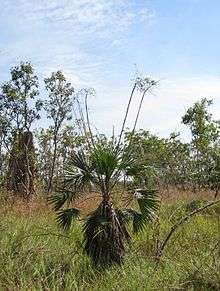Livistona humilis
| Livistona humilis | |
|---|---|
 | |
| Scientific classification | |
| Kingdom: | Plantae |
| (unranked): | Angiosperms |
| (unranked): | Monocots |
| (unranked): | Commelinids |
| Order: | Arecales |
| Family: | Arecaceae |
| Subfamily: | Coryphoideae |
| Genus: | Livistona |
| Species: | L. humilis |
| Binomial name | |
| Livistona humilis R.Br. | |
The sand palm, Livistona humilis, is a member of the Arecaceae family. It is a small, slender palm, growing to about 7 m tall and 5–8 cm dbh. It has 8 to 15 fan-shaped leaves, 30-50 cm long with petioles 40-70 cm long. It is endemic to the Top End of the Northern Territory in Australia. Genetic investigation suggests that its closest relation is Livistona inermis.[1] This palm is fire tolerant and usually grows in environments where it is exposed to frequent fires.[2]
Livistona humilis is sexually dimorphic. The flower stalks on the female plant are erect and up to 230 cm long, while the male plant's flower stalks are up to 180 cm long and curved. The flowers are small and yellow, 2 mm to 4 mm across. Fruit is shiny purple black, ellipsoid, pyriform, or obovoid, 11-19 mm long and 8-10 mm in diameter.[1]
The name comes from the Latin humilis, meaning "low" - referring to its small stature.[3]
The holotype of this species was collected in January 1803 by Robert Brown from Morgans Island in the Gulf of Carpentaria.[1]
Distribution and habitat
The sand palm is endemic to the north of the Northern Territory of Australia, from the Fitzmaurice River to Cape Arnhem and inland as far as Katherine. It occurs in open forest and woodland up to about 240 m above sea level, most commonly on deep sandy soils and sandy lateritic soils, but it is found in various soils and rocky areas. It frequently grows beneath a eucalypt understorey.[1][2]
Phenology
Flowering: September to May. Fruiting: January to June.[2]
Traditional use
Aboriginal people use this palm in a number of ways. The fruits are edible. The heart (central growing tip) can be eaten, either raw or roasted. The core of the stem is pounded and made into a drink which is used to treat coughs, colds, chest infections, diarrhea, and tuberculosis. Backache is treated with the crushed stem core. The fruit and growing shoot can be used as a black or purple dye.[2]
Conservation status
Not currently included in the Northern Territory threatened species list.[4]
References
- 1 2 3 4 Dowe, JL (2010), Australian Palms : Biogeography, Ecology and Systematics, Melbourne, Vic: CSIRO Publishing, pp. 110–112, ISBN 9780643096158
- 1 2 3 4 Brock, John (2001), Native plants of northern Australia, Frenchs Forest, NSW: Reed New Holland, p. 238, ISBN 1877069248
- ↑ Napier, D; Smith, N; Alford, L; Brown, J (2012), Common Plants of Australia's Top End, South Australia: Gecko Books, pp. 50–51, ISBN 9780980852523
- ↑ Department of Land Resource Management (2015), Threatened Species List, Northern Territory Government, retrieved 27 March 2015
| Wikimedia Commons has media related to Livistona humilis. |